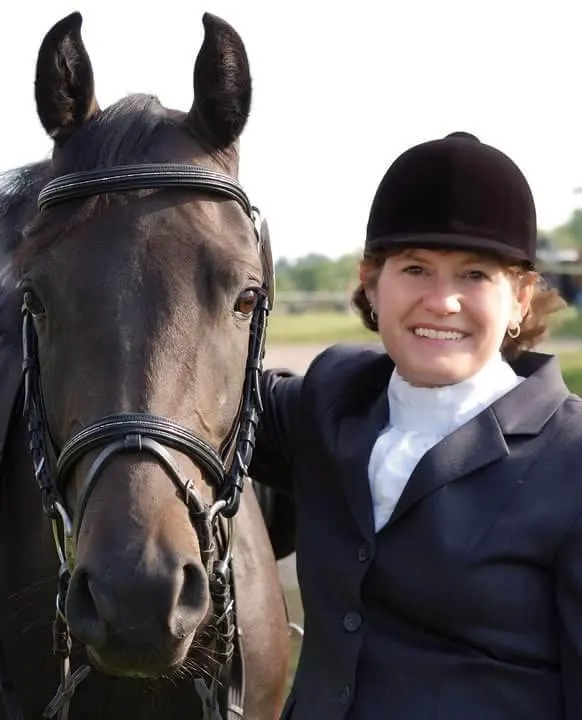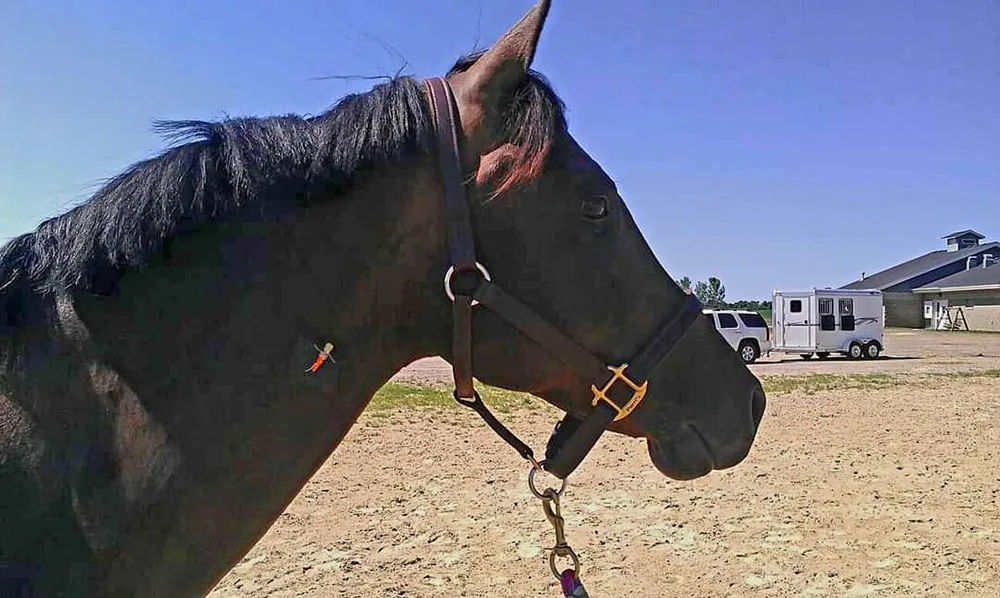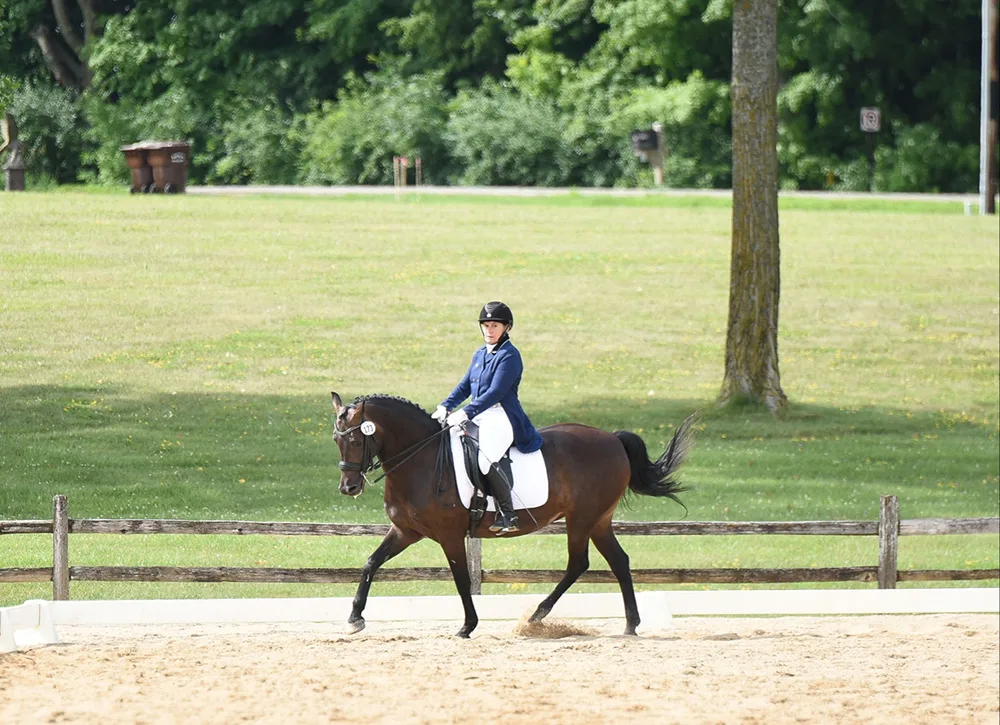When Brenda Thoma received a phone call instead of a text from Maple Creek Stables barn manager Kara Micelli on a July evening in 2013, she knew immediately it was something serious.
“Kara isn’t an alarmist,” Thoma said. “So if Kara calls, you know there’s something going on.”
Micelli reported that Thoma’s 10-year-old Morgan mare, Hollyhock Bella Luna, had been double-barrel kicked by another horse while coming in from turnout. Although the single kick struck both of “Eclipse’s” hocks, she didn’t appear injured beyond a few seemingly superficial scratches. But when Micelli checked on Eclipse 20 minutes later, she noticed clear fluid running from the wounds and down both hind legs. Despite the hour, Micelli urged Thoma to place a call to their veterinarian.
Thoma hurried to the farm in Maple Lake, Minnesota, where she found Eclipse happily eating dinner, seemingly unconcerned about the situation. While they waited for the arrival of J.C. Thieke, DVM, of Anoka Equine Veterinary Services, Thoma used diapers to wrap ice over both hocks. The wounds looked so small, she wasn’t overly worried at first. But her mindset instantly changed when the normally willing Eclipse strongly resisted leaving her stall once it was time for Thieke to perform his initial assessment.
“She is an incredibly stoic horse,” Thoma said. “Nothing gets to her. She comes from a line of war horses that trace back to the Civil War; she’s tough, and a survivor. And she didn’t want to walk out of her stall.”

Imaging revealed that while the bones were uninjured, the hock bursas in each leg had ruptured. The “clear fluid” seen running down Eclipse’s legs was synovial fluid, leaking from the ruptured bursas and out through the small wounds. But more concerning to Thieke was the risk of joint sepsis. He recommended Eclipse be shipped to his clinic for immediate surgery to flush the joints.
“When he looked at her, he did that sad headshake vets do that makes your heart sink,” Thoma said. “They may not say anything negative, but the look makes you go, ‘Oh no.’ ”
By the time Thoma’s friend Linda Munn arrived with her trailer (Thoma’s was in the shop, and most of the barn was at a show), Eclipse was showing increased signs of distress. After a slow, uncomfortable walk down the barn aisle, the mare stopped short at the step onto the trailer.
“She’s always hopped on the trailer no problem,” Thoma said. “But she couldn’t put the weight on her back legs to get in the trailer. That’s when I cried for the first time. She had a look on her face of genuine fear that I’d never seen in all the years I owned her.”
With the assistance of several strong bystanders, Eclipse was helped into the trailer and made the half-hour trip to the clinic. By 10 p.m. she was in surgery, where Thieke opened the wounds, thoroughly flushed the joints and set the incisions up to heal. Several friends waited with Thoma for news, including her longtime trainer, Peggy Gomez.
It was close to midnight before the procedure was complete. A culture of the joints prior to surgery had indeed revealed bacteria, and Thieke warned Thoma it was now a matter of waiting to see if the flushing and IV antibiotics would do their job. Eclipse would need to remain at the clinic, with a port installed, to continue her antibiotic treatment for the next several days.
Just before leaving for the night, Thoma went to see Eclipse, who was still laying down in the recovery stall. All Thoma could think was that her normally robust partner suddenly looked so vulnerable. She went home with this image seared in her mind’s eye, hoping for good news in the morning.
Rehab For ‘An Energy-Conserving Kind Of Gal’
ADVERTISEMENT
When Thoma purchased Eclipse, she didn’t have any major aspirations for the 4-year-old mare beyond simply having fun. Thoma has always enjoyed jumping and competing in low-level events, and she mostly practiced dressage as it related to those pursuits. She soon learned that Eclipse was quite intelligent and a quick learner, and she began taking more advanced dressage lessons with Gomez, in addition to her weekly jumping lesson, to help engage the mare’s mind.
The pair made their competitive dressage debut only two months prior to Eclipse’s injury, showing at training and first levels.
“She’s designed for hauling logs out in the woods,” Thoma said with a laugh. “She’s not designed for [dressage]. She’s an energy-conserving kind of gal, which is good because as a driving horse, that’s what you’re supposed to do. When you stop, you go into park mode, because you might have to work really hard later.”
It was perhaps due in part to this quality of Eclipse’s temperament that she handled her post-surgical circumstances so well. By the day after her surgery, Eclipse’s attitude had already improved significantly. She was eating well, and by afternoon, willingly went for a handwalk down the barn aisle, despite being bandaged nearly to her stifles. The following day, Thoma was allowed to take Eclipse outside to hand graze—an act of normalcy that brought Thoma great comfort, despite the port still in her mare’s neck. Several days later, Eclipse was released from the hospital with a good prognosis.
“Had Kara not called me, had I not gone out, had it waited until morning—she might not have been saved,” Thoma said. “She had a super recovery because of the timing, with no permanent damage to the ligaments, tendons or joints.”

When she returned home, Eclipse was restricted to a stall, and then a small paddock. Starting with handwalking, first just around the yard, then later along trails on the property, Thoma gradually rebuilt Eclipse’s fitness. They progressed to saddle work and, six weeks later, trotting and easy interval work under tack.
“The bursa repairs itself and refills,” she said. “But I wanted to make sure there was fluid in those joints before I started doing anything significant with them!”
From Schooling To Shadbelly
Soon, Thoma and Eclipse were back to their previous routine, taking one or two dressage lessons per week, and enjoying a group jumping lesson every Saturday morning. In 2014, 10 months after her injury, Eclipse returned to the show ring at first level—then tackled second level the following year.
Almost before she knew it, Thoma and her 14.1-hand “fun-sized” partner were competing at third level, and Thoma earned her U.S. Dressage Federation bronze medal.
“I tell people all the time that the real key to our success is I just love to ride this horse,” Thoma said. “She is so fun. I like the journey. I like every lesson. I like grooming her. I love all of that, and that’s why we’ve been successful.
“People will say, ‘You must have been really dedicated and worked really hard’, and I say, ‘No, not really,’ ” Thoma continued with a laugh. “The success is a byproduct of what I love to do, which is ride.”
As Thoma and Eclipse continued their dressage journey, they also began taking lessons with Gomez’s colleague, dressage trainer Mary Beth Williams. Although Thoma has done the majority of Eclipse’s training herself, Williams was instrumental in helping the pair to learn new movements—such as flying changes and pirouettes—that Thoma had never performed. But even when it wasn’t her turn to ride, Thoma was still present, studying the sport from the ground.
“I am a visual learner, so to see someone else do it was helpful for me,” she said. “Mary Beth would make it more clear to Eclipse, then I could get on, and she would suffer me well.
ADVERTISEMENT
In 2021, Thoma and the then 18-year-old Eclipse cantered down the centerline in their first-ever Prix St. Georges. As she and her petite Morgan shared the warm-up with big, powerful warmbloods, instead of being intimidated, Thoma reflected on her special mare’s unique qualities.
“Eclipse is the exact horse at the horse show she is at home,” Thoma said. “The work we do at home is good, and when we get to the show, it’s just the same. It shows you don’t have to have a fabulous-moving horse to be successful.
“She can really do a fabulous half-pass,” Thoma continued. “The extended trot—meh, she doesn’t have that je ne sais quoi that the horses who are bred for it do. But voltes are really easy, because she’s so small, and the tempis on the diagonal? We have all kinds of time!”

As Eclipse approaches her 20th birthday this year, her work ethic is in no way diminished. At home, they are schooling Intermediaire I, and this year, Thoma hopes to collect the remaining score at Prix St. Georges necessary to complete her USDF silver medal.
“If I get that last score, great, and if I don’t, I’m going to enjoy the heck out of it,” she said. “It’s frosting now, at this point. Just being able to show at that level is satisfying.”
Thoma credits Eclipse’s longevity largely to good genes and attentive care—but notes that her mare’s mid-life injury did change how she viewed the process of conditioning for dressage success. At least in part, Thoma attributes Eclipse’s continued fitness to this evolved mindset.
“I became hyper-aware of making sure Eclipse had the musculature to support the joints, to keep her safe and strong,” Thoma said. “You have to tend to the basics, and do the drills and the strengthening to get the hindquarter strong enough to do a canter pirouette, for example. You can’t get on and just expect them physically to do things.
“I wanted a horse that was going to last,” Thoma continued. “Here she is, 20 this year, and she’s probably in the best shape of her life.”
Last fall, Maple Creek Stables closed, and after 16 years together, Thoma’s barn community dispersed to new facilities. Eclipse and Thoma landed at Orchard View Stables in Watertown, Minnesota, where they now work with FEI trainer Heather Salden-Kurtz. But every Saturday morning, a group of former Maple Creek riders—including Thoma’s adult daughter, Lauren Ergen—still get together for their weekly jumping lesson. And on that day, Thoma trades her centerlines for bending lines, and happily joins in, just as she has since Eclipse was young.
“We have a good time,” Thoma said. “I think it’s really good for [Eclipse], and it pushes my comfort level quite a bit.”
While Thoma never envisioned herself competing in a shadbelly or schooling lines of two-tempi changes, she is inherently grateful for the unique journey she and Eclipse have taken together.
“It’s just such a lesson, that you can learn anything, sometimes accidentally, if you just keep riding that horse and keep doing your thing,” she said. “Even if you are not a fabulous rider, even if the horse is not designed for it—you can do great things. You just have to show up, get a good trainer, and if you enjoy it enough and keep doing it, it unfolds the way it’s supposed to unfold.”
Do you know a horse or rider who returned to the competition ring after what should have been a life-threatening or career-ending injury or illness? Email Kimberly at kloushin@coth.com with their story.














